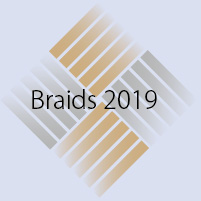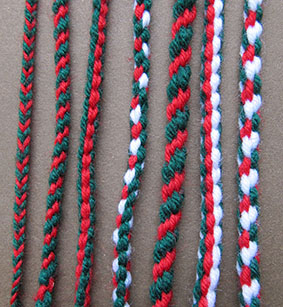
4th International Conference on Braids, Iga
13-18 October 2019

| Karakumidai | Monday to Tuesday | |||
| Room | Tutor | Title | Capacity | |
| 4Ka1 | Masumi & Makiko Tada | Kumihimo with Karakumi-dai and board | 10 | |
| In this class, students will study the basics of Karakumi-dai braiding. The students will make some samples on Karakumi-dai and on board to know the structure of Karakumi. |  |
|||
| Student level | Student supply list | |||
| From beginner to expert | 48 EZ bobbins, writing tools, scissors, 2 bulldog clips and a hard corrugated board (about 30 cm x 40 cm) | |||
| Materials fee: 2000 JPY | ||||
| Items included in this fee: Silk Karakumi threads, thick yarn, a starting stick. | ||||
| Takadai | Monday to Tuesday | |||
| Room | Tutor | Title | Capacity | |
| 5T1 | Michael Hattori | Braid sleuthing 101: How do I make that braid? | 10 | |
| An intensive 2-day hands-on workshop centered around understanding takadai braid structure so that one may reproduce braids for which there is no instruction. We will start by examining various takadai braids, intuiting their structure by visual examination: what clues are present in colors, edges, number of ridges, and much more. After this, students will be given a photo of a takadai braid and, using their newly learned "sleuthing" skill, challenged to reproduce that braid. The key to the braid will be given near the end of the class, with a short discussion of the solution. |  |
|||
| Student level | Student supply list | |||
| This is only for advanced takadai students and they must have experience with a wide variety of both 1- and 2-level takadai braids, particularly Nimai Kôraigumi, and a braid such as Kikkôgumi or Kainokuchi. Ability to read and construct takadai graphs will be assumed. | Notepad, pencils, pen, good scissors, takadai with 60 tama (70, 85 or 100g), takadai diagramming paper or square graph paper for plotting your braid (I will have extra in case you forget). Each student will need to make up a 60 tama warp, 30 tama each in 2 contrasting colors; length should be at least 1 meter. |
|||
| Materials fee: 1600 JPY | ||||
| IItems included in this fee: Two class handouts: Understanding Takadai Braid Structure; The Solution. | ||||
| Takadai | Thursday to Friday | |||
| Room | Tutor | Title | Capacity | |
| 5T2 | Jennie Parry | Folds & holes on Takadai | 12 | |
| We shall look at methods of creating folds as well as lacey type braids by using some particular combinations of special yarns, structures and finishing methods. Students will be encouraged to make short samples under guidance. I shall demonstrate ways of managing some of these willful yarns whilst warping the takadai, and different methods required to attach the tama to some of the yarns. I shall bring a good selection of prepared packets of warps of unusual fibres such as paper, high twist wool and also silk, linen, gimp, lycra, elastine, soluble yarns and monofilament. Each activity will build on the skills acquired. |  |
|||
| Student level | Student supply list | |||
| Experience of setting up takadai quickly, to be familiar with working Anda, 2/2 twill, 3/3, and to working with odd and even numbers of tama. Ability to record own handmoves. | Notebook, pencil, 2 coloured pencils, correcting fluid, scissors, tie-on labels, 5 medium plastic bags, clippets (plastic bag fasteners), glass topped pins, 2 x A4 pieces of polystyrene or thin cork, small mirror. | |||
| Materials fee: 1000 JPY | ||||
| Items included in this fee: Sufficient prepared warps of various materials for 4 samples, record sheets. | ||||
| Disk & Plate | Monday, Tuesday and Friday | |||
| Room | Tutor | Title | Capacity | |
| 3D1 | Hiroko Ojima | Flower of Kumihimo | 12 | |
| Using a special Kumihimo plate, students make a wide zigzag deformed braid for corsages. Because it takes time, the students will not make it up. However, the students will be able to learn how to make a corsage. Finish it during the conference and decorate yourself for the farewell party. Materials are paper thread, fishing line, ultrafine wires, metallic threads and so on. |  |
|||
| Student level | Student supply list | |||
| Experience of Kumihimo Plate braiding with 16 threads is required. | Note taking items, scissors. | |||
| Materials fee: 2500 JPY | ||||
| Items included in this fee: Threads, a special Kumihimo Plate, a corsage pin. | ||||
| Room | Tutor | Title | Capacity | |
| 3D2 | Hiroko Ojima | Kohrai-gumi on the disk & plate | 12 | |
| Kohrai-gumi are normally made on Takadai. In this class, we will make Kohrai-gumi with Kumihimo disk or plate for easy assembly. In the morning, we set up samples with thick yarns and in the afternoon we use special twisted threads to make bracelets or necklaces. We will make an integral part and a part divided into two making efficient use this technique. |  |
|||
| Student level | Student supply list | |||
| Experience of Kumihimo Plate braiding with 16 threads is required. | Note taking items, scissors, 16 EZ bobbins. | |||
| Materials fee: 2000 JPY | ||||
| Items included in this fee: Yarns, threads, buttons. | ||||
| Room | Tutor | Title | Capacity | |
| 3D3 | Bob Galivan | Beaded Anda-gumi bracelet | 12 | |
| Learn how to make a unique and lovely kumihimo bracelet with endless possibilities for design. Students will have a choice of several colorways and bead combinations, using a blend of Toho's hex, demi, and round seed beads. Students will learn how to start and end the braid, and how to incorporate beads into the fiber structure, using my adaptation of the traditional Anda-gumi kumihimo braid worked on the square plate. We will also discuss how to develop patterns for the braid, using different types and shapes of beads. In the weeks before the class, the instructor will work online with students to define colorways and patterns, so that the class can focus on technique and braiding. |  |
|||
| Student level | Student supply list | |||
| Beginners – students do not need any experience in braiding. | Scissors, measuring tape, magnifiers (optional), task lamp (optional) | |||
| Materials fee: 4500 JPY | ||||
| Items included in this fee: TOHO Amiet thread, square braiding plate, assorted beads to complete project, magnetic clasp, printed instructions | ||||
| Room | Tutor | Title | Capacity | |
| 5D1 | Shirley Berlin | Not Kumihimo – The Laramie braid | 15 | |
| The Laramie was originally a straw-plaiting braid, with its origins in Europe. It is a big sister of the seven strand Fill-the-Gap braid and was developed and named on a long car journey by Shirley and Carol Goodwin. The threads are braided around “core threads” which opens many possibilities. The colours can come and go and the braid can be fine or chunky or even twisty, depending on the size of the core and the distribution of the threads around the disc. Variations include braiding with beads on some strands and using wire. We will have time to try several variations and you should be able to complete a project of your choice if you wish. |  |
|||
| Student level | Student supply list | |||
| Beginners are welcome in this class, but experienced braiders will achieve more. | Scissors, pen/pencil, eyeglasses. Jewellery tools, if you have them. | |||
| Materials fee: 1500 JPY | ||||
| Items included in this fee: 3 foam discs, beads, wire, findings, glue Instruction booklet | ||||
| Loop braiding | Monday, Tuesday, Thurday to Friday | |||
| Room | Tutor | Title | Capacity | |
| 4L1 | Jean Leader | Introduction to fingerloop braiding |
12 | |
A workshop for students with no experience of fingerloop braiding where they will be introduced to the basics and try working spiral braids with 2, 4 or 6 loops (see right photo), and square braids with 3 or 5 loops (see photos below). Topics covered would include threads, starting and finishing a braid, and working with both single-colour and bi-colour loops. |
 |
|||
| Student level | Student supply list | |||
| No previous experience of fingerloop braiding needed. | G-clamp (C-clamp in US) and cardboard or similar to protect the table. | |||
| Materials fee: 150 JPY | 3-loop braids | 5-loop braids | ||
| Items included in this fee: Instruction sheets and some threads. |  |
 |
||
| Room | Tutor | Title | Capacity | |
| 4L2 | Masumi Tada | Kute-uchi: ancient loop braiding technique | 12 | |
| In this class, students will learn the basics of “Kute-uchi” loop braiding technique. Next, a pair of two students will braid the Saidaiji-gumi. Saidaiji-gumi is "The string of sacks of sutra” left in the Saidaiji Temple of Nara and a National Treasure of Japan. |  |
|||
| Student level | Student supply list | |||
| From beginner to expert | G-clamp, writing tools. | |||
| Materials fee: 1000 JPY | ||||
| Items included in this fee: Threads and yarn. | ||||
| Room | Tutor | Title | Capacity | |
| 4L3 | Joy Boutrup | European traditional loop braiding | 14 | |
| The workshop will give a short historical insight into the tradition of loop braiding in Europe. The principles of working with loops will be demonstrated and explained. In the beginning all will work individually. Later when a certain proficiency has been obtained, (normally after ½ a day) there will be possibilities of cooperation between two or three participants. Different instructions based on historical manuscripts and on resent research will be provided and can be tried individually or in small groups. A large number of actual samples will be shown and explained. The types covered are: • Oblique interlacing: flat single layered, flat double layered, round double layered with exchange of layers, unorthodox structures, round compact, • Oblique twining in different sections and with change of direction, • Cross wise exchange of loops, and • Orthodox and unorthodox exchange of loops between workers. |  |
|||
| Student level | Student supply list | |||
| Primary experience with loop braiding is fine but not necessary. Loop braiding is easy to learn, the basics take around an hour to master manually. The more intricate features take a little longer time. In two days several samples of diverse types can be produced by all but not everyone will be able to grasp the more theoretical parts of loop braiding. | Personal favorite yarns, preferably not too hairy, for samples. | |||
| Materials fee: 1200 JPY | ||||
| Items included in this fee: Mercerized cotton and natural dyed silk provided by me for samples. | ||||

4th International Conference on Braids, Iga
13-18 October 2019
